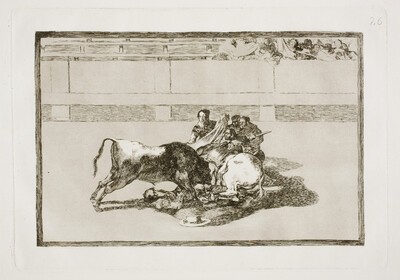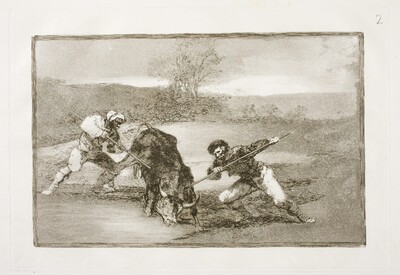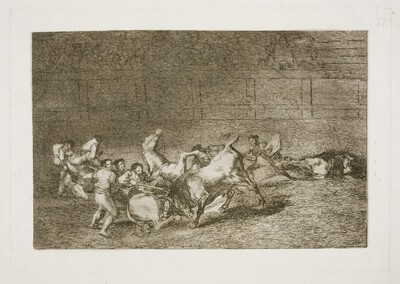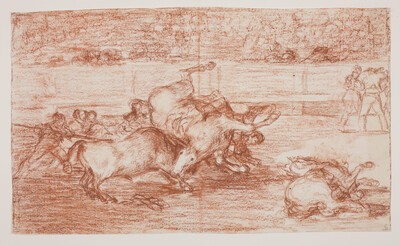- Cronología
- 1814 - 1815
- Dimensiones
- 246 x 348 mm
- Técnica y soporte
- Aguafuerte, aguatinta, punta seca y bruñidor
- Reconocimiento de la autoría de Goya
- Documented work
- Ficha: realización/revisión
- 29 Sep 2021 / 22 Jun 2023
- Inventario
- -
- Otros títulos:
-
B (print, upper right-hand corner)
Goya (print, bottom right-hand corner)
See How the ancient Spaniards hunted bulls on horseback in the countryside.
This print, discarded by Goya and not included in the first edition of Bullfighting of 1816 because of faults in the aquatint bite, was added and published for the first time, along with six others (A-G), in the third edition of the series, printed by Eugène Loizelet in Paris in 1876. It was retained in subsequent editions of the Bullfighting.
A condition test made before the lettering was engraved is preserved.
The plate is kept at the National Chalcography (nº 368), with Another way of hunting on foot engraved on the obverse.
See How the ancient Spaniards hunted bulls on horseback in the countryside.
This scene is very agitated and saturated with characters, like most of the scenes Goya painted at the beginning of the original series. The use of aquatint is striking, the vigorous effect it creates giving the scene a dramatic character. Paradoxically, for this reason, because of the effects created by the aquatint in the right half of the composition, Goya is thought to have discarded the print from the original series.
We see a bull being carried off a horse, which is completely turned around and the picador who was riding it is falling on the other side. Behind appears a large group of men, probably pimps, who try to separate the bull from the horse, whipping it with pikes, while they watch the scene without getting too excited.On the right-hand side there is another group of three men with their backs to the bullring. The light especially illuminates the cruellest part of the scene, the encounter between the horse and the bull, and part of the group of men on the left. The right half of the composition is illuminated by the curious effect generated by the aquatint.
In terms of subject matter, the print is related to two engravings from the original Bullfighting series, specifically Fall of a bullfighter from his horse under the bull and Two groups of bullfighters being run over by a single bull at once, as the subject matter is the same.
Lafuente Ferrari stresses that the engraving has the typical characteristics of the first scenes in the series. Martínez-Novillo, for his part, points out that the three scenes showing the fall of the picadors (26, 32 and B) are among the most important in the series, as they reflect the events with notable veracity, movement and violence, both conceptually and visually. Furthermore, he rules out the possibility that they reflect anti-bullfighting ideas, as some authors have suggested, as in reality what Goya did was to tell the events as they happened, although he was aware of their plasticity. He thinks, however, that in this case he may have introduced a certain degree of self-censorship due to the crudeness of the scene, which in principle he was satisfied with, as he signed it on the plate. He relates it to the other prints in the series that deal with the suerte de varas and its incidents (22, 26-28 and 32).
There is a preparatory drawing of the present print, also titled Unfortunate charge of a powerful bull (Bullfighting B).
-
Grabados y dibujos de Goya en la Biblioteca NacionalBiblioteca NacionalMadrid1946catalogue Elena Páez Ríos
-
Goya en la Biblioteca Nacional. Exposición de grabados y dibujos en el sesquicentenario de su muerteBiblioteca NacionalMadrid1978May - June 1978
-
Grabados de Goya: colección propiedad de la Biblioteca Nacional, que se conserva en su Gabinete deCasa de la Amistad de MoscúMoscow1979exhibition displayed from January 18th to 31st 1979
-
1984
-
Madrid1987
-
Madrid1990
-
Goya grabadorFundación Juan MarchMadrid1994consultant editors Alfonso E. Pérez Sánchez and Julián Gállego, from January 14th to March 20th 1994
-
Goya grabadorMuseo del Grabado Español ContemporáneoMarbella1996from March 8th to May 5th 1996
-
Schlaf der Vernunft. Original radierungen von Francisco de GoyaMunich2000
-
Madrid2002
-
Madrid2002
-
Bilbao2012
-
Goya luces y sombrasCaixaForumBarcelona2012consultant editors José Manuel Matilla and Manuela B. Marqués. From March 16th to June 24th 2012cat. 60
-
Zaragoza2017
-
1946pp. 177-216, espec. pp. 185 y 210
-
BarcelonaTartessos-F. Oliver Branchfelt1946 (reed. 1951)
-
OxfordBruno Cassirer1964vol. II, 1964, p. 352, cat. 238
-
Vie et ouvre de Francisco de GoyaParísOffice du livre1970p. 280, cat. 1221
-
Goya, toros y torerosMadridMinisterio de Cultura, Comunidad de Madrid1990p. 118, cat. 51
-
MadridCaser-Turner1992pp. 21, 35-36 y 39
-
Catálogo de las estampas de Goya en la Biblioteca NacionalMadridMinisterio de Educación y Cultura, Biblioteca Nacional1996cat. 360
-
MadridMuseo Nacional del Prado2001pp. 100-101
-
Goya. In the Norton Simon MuseumPasadenaNorton Simon Museum2016pp. 186-201




